High-Density Wi-Fi Based Sensor Network for Efficient Irrigation Management in Precision Agriculture
Abstract
:Featured Application
Abstract
1. Introduction
2. Materials and Methods
2.1. Experimental Plot
2.2. Irrigation Treatments
2.3. WSN Infrastructure
2.4. Agronomic Sensors
- A total of four sensors per replicate (twelve in total) deployed as follows: two volumetric soil water content sensors (10HS, Decagon devices, Inc., Pullman, WA, USA) and two matric potential of soil water sensors (MPS-6, Decagon devices, Inc., Pullman, WA, USA), installed at 23 cm from each dripper and 25 and 45 cm depth located under the canopy and along the tree drip lines.
- A total of two linear variable displacement transducer sensors (LVDT, Model DF ± 2.5 mm, Solartron Metrology, Bognor Regis, UK) per replicate (six in total) were installed on the main tree branch for measuring micrometric branch diameter variations.
- A total of two infrared radiometer sensors (IR120, Campbell Scientific Inc., USA) per treatment were mounted on wooden poles and installed at 0.5–1.0 m over the trees canopy for monitoring canopy temperature.
- A total of four climatic sensors (VP4, Decagon devices, Inc., Pullman, WA USA) were installed to record air temperature, relative humidity and vapor pressure deficit.
2.5. Sensor Nodes
2.6. Time Synchronization
3. Results and Discussion
3.1. Consumption of Type A Nodes
3.2. Consumption of Type B Nodes
3.3. Sensor Data Validation
3.4. Reliability of the Nodes
3.5. Typical Node Failures
4. Conclusions
Author Contributions
Funding
Conflicts of Interest
References
- Food and Agriculture Organization of the United Nations. Deficit Irrigation Practices; Food and Agriculture Organization of the United Nations: Rome, Italy, 2002; Volume 22. [Google Scholar]
- Yu, L.; Zhao, X.; Gao, X.; Siddique, K.H.M. Improving/maintaining water-use efficiency and yield of wheat by deficit irrigation: A global meta-analysis. Agric. Water Manag. 2020, 228, 105906. [Google Scholar] [CrossRef]
- Pardo, J.J.; Martínez-Romero, A.; Léllis, B.C.; Tarjuelo, J.M.; Domínguez, A. Effect of the optimized regulated deficit irrigation methodology on water use in barley under semiarid conditions. Agric. Water Manag. 2020, 228, 105925. [Google Scholar] [CrossRef]
- Kang, S.; Zhang, L.; Liang, Y.; Hu, X.; Cai, H.; Gu, B. Effects of limited irrigation on yield and water use efficiency of winter wheat in the Loess Plateau of China. Agric. Water Manag. 2002, 55, 203–216. [Google Scholar] [CrossRef]
- Du, T.; Kang, S.; Zhang, J.; Davies, W.J. Deficit irrigation and sustainable water-resource strategies in agriculture for China’s food security. J. Exp. Bot. 2015, 66, 2253–2269. [Google Scholar] [CrossRef]
- Blanco, V.; Torres-Sánchez, R.; Blaya-Ros, P.J.; Pérez-Pastor, A.; Domingo, R. Vegetative and reproductive response of ‘Prime Giant’ sweet cherry trees to regulated deficit irrigation. Sci. Hortic. 2019, 249, 478–489. [Google Scholar] [CrossRef]
- Haule, J.; Michael, K. Deployment of wireless sensor networks (WSN) in automated irrigation management and scheduling systems: A review. In Proceedings of the 2nd Pan African International Conference on Science, Computing and Telecommunications, PACT 2014, Arusha, Tanzania, 14–18 July 2014; pp. 86–91. [Google Scholar]
- Wang, N.; Li, Z. Wireless sensor networks (WSNs) in the agricultural and food industries. In Robotics and Automation in the Food Industry: Current and Future Technologies; Elsevier Ltd.: Amsterdam, The Netherlands, 2012; pp. 171–199. ISBN 9781845698010. [Google Scholar]
- Balendonck, J.; Hemming, J.; van Tuijl, B.A.J.; Incrocci, L.; Pardossi, A.; Marzialetti, P. Sensors and wireless sensor networks for irrigation management under deficit conditions (FLOW-AID). In Proceedings of the International Conference on Agricultural Engineering (AgEng 2008), Hersonissos, Crete, 23–25 June 2008; pp. 3–452. [Google Scholar]
- Elijah, O.; Rahman, T.A.; Orikumhi, I.; Leow, C.Y.; Hindia, M.N. An Overview of Internet of Things (IoT) and Data Analytics in Agriculture: Benefits and Challenges. IEEE Internet Things J. 2018, 5, 3758–3773. [Google Scholar] [CrossRef]
- Jawad, H.M.; Nordin, R.; Gharghan, S.K.; Jawad, A.M.; Ismail, M. Energy-efficient wireless sensor networks for precision agriculture: A review. Sensors 2017, 17, 1781. [Google Scholar] [CrossRef] [Green Version]
- Aqeel-ur-Rehman; Abbasi, A.Z.; Islam, N.; Shaikh, Z.A. A review of wireless sensors and networks’ applications in agriculture. Comput. Stand. Interfaces 2014, 36, 263–270. [Google Scholar] [CrossRef]
- De Oliveira, K.V.; Castelli, H.M.E.; Montebeller, S.J.; Avancini, T.G.P. Wireless Sensor Network for Smart Agriculture Using ZigBee Protocol. In Proceedings of the 2017 IEEE 1st Summer School on Smart Cities, S3C 2017—Proceedings, Natal, Brazil, 6–11 August 2017; pp. 61–66. [Google Scholar]
- Prakash, S. Zigbee based wireless sensor network architecture for agriculture applications. In Proceedings of the 3rd International Conference on Smart Systems and Inventive Technology, ICSSIT 2020, Tirunelveli, India, 20–22 August 2020; pp. 709–712. [Google Scholar]
- Rodríguez, S.; Gualotuña, T.; Grilo, C. A System for the Monitoring and Predicting of Data in Precision Agriculture in a Rose Greenhouse Based on Wireless Sensor Networks. In Proceedings of the Procedia Computer Science; Elsevier B.V.: Amsterdam, The Netherlands, 2017; Volume 121, pp. 306–313. [Google Scholar]
- Sahitya, G.; Balaji, N.; Naidu, C.D. Wireless sensor network for smart agriculture. In Proceedings of the 2016 2nd International Conference on Applied and Theoretical Computing and Communication Technology, iCATccT 2016, Bengaluru, Karnataka, India, 21–23 July 2016; pp. 488–493. [Google Scholar]
- Samijayani, O.N.; Darwis, R.; Rahmatia, S.; Mujadin, A.; Astharini, D. Hybrid ZigBee and WiFi Wireless Sensor Networks for Hydroponic Monitoring. In Proceedings of the 2nd International Conference on Electrical, Communication and Computer Engineering, ICECCE 2020, Istanbul, Turkey, 12–13 June 2020. [Google Scholar]
- Xiao, J.; Li, J.T. Design and implementation of intelligent temperature and humidity monitoring system based on ZigBee and WiFi. In Proceedings of the Procedia Computer Science; Elsevier B.V.: Amsterdam, The Netherlands, 2020; Volume 166, pp. 419–422. [Google Scholar]
- Wang, Z.; Jiang, Z.; Hu, J.; Song, T.; Cao, Z. Research on Agricultural Environment Information Collection System Based on LoRa. In Proceedings of the 2018 IEEE 4th International Conference on Computer and Communications (ICCC), Chengdu, China, 7–10 December 2018; pp. 2441–2445. [Google Scholar]
- Albaladejo, C.; Soto, F.; Torres, R.; Sánchez, P.; López, J.A. A Low-Cost Sensor Buoy System for Monitoring Shallow Marine Environments. Sensors 2012, 12, 9613–9634. [Google Scholar] [CrossRef]
- López, J.; Soto, F.; Sánchez, P.; Iborra, A.; Suardiaz, J.; Vera, J. Development of a Sensor Node for Precision Horticulture. Sensors 2009, 9, 3240–3255. [Google Scholar] [CrossRef]
- Navarro-Hellín, H.; Torres-Sánchez, R.; Soto-Valles, F.; Albaladejo-Pérez, C.; López-Riquelme, J.A.; Domingo-Miguel, R. A wireless sensors architecture for efficient irrigation water management. Agric. Water Manag. 2015, 151, 64–74. [Google Scholar] [CrossRef] [Green Version]
- Riquelme, J.A.L.; Soto, F.; Suardíaz, J.; Sánchez, P.; Iborra, A.; Vera, J.A. Wireless Sensor Networks for precision horticulture in Southern Spain. Comput. Electron. Agric. 2009, 68, 25–35. [Google Scholar] [CrossRef]
- Alahi, M.E.E.; Pereira-Ishak, N.; Mukhopadhyay, S.C.; Burkitt, L. An Internet-of-Things Enabled Smart Sensing System for Nitrate Monitoring. IEEE Internet Things J. 2018, 5, 4409–4417. [Google Scholar] [CrossRef]
- Bhattacherjee, S.S.; Shreeshan, S.; Priyanka, G.; Jadhav, A.R.; Rajalakshmi, P.; Kholova, J. Cloud based Low-Power Long-Range IoT Network for Soil Moisture monitoring in Agriculture. In Proceedings of the 2020 IEEE Sensors Applications Symposium (SAS), Kuala Lumpur, Malaysia, 9–11 March 2020; pp. 1–5. [Google Scholar]
- Jing, L.; Wei, Y. Intelligent Agriculture System Based on LoRa and Qt Technology. In Proceedings of the 31st Chinese Control and Decision Conference, CCDC 2019, Nanchang, China, 3–5 June 2019; pp. 4755–4760. [Google Scholar]
- Kokten, E.; Caliskan, B.C.; Karamzadeh, S.; Soyak, E.G. Low-Powered Agriculture IoT Systems with LoRa. In Proceedings of the 2020 IEEE Microwave Theory and Techniques in Wireless Communications (MTTW), Riga, Latvia, 1–2 October 2020; pp. 178–183. [Google Scholar]
- Ma, Y.W.; Chen, J.L. Toward intelligent agriculture service platform with lora-based wireless sensor network. In Proceedings of the 4th IEEE International Conference on Applied System Innovation 2018, ICASI 2018, Chiba, Japan, 13–17 April 2018; pp. 204–207. [Google Scholar]
- Mohammed, T.S.; Khan, O.F.; Al-Bazi, A. A Novel Algorithm Based on LoRa Technology for Open-Field and Protected Agriculture Smart Irrigation System. In Proceedings of the 2019 2nd IEEE Middle East and North Africa COMMunications Conference, MENACOMM 2019, Manama, Bahrain, 19–21 November 2019. [Google Scholar]
- Nursyahid, A.; Aprilian, T.; Setyawan, T.A.; Helmy; Nugroho, A.S.; Susilo, D. Automatic sprinkler system for water efficiency based on lora network. In Proceedings of the 2019 6th International Conference on Information Technology, Computer and Electrical Engineering, ICITACEE 2019, Semarang, Indonesia, 26–27 September 2019.
- Sarker, V.K.; Queralta, J.P.; Gia, T.N.; Tenhunen, H.; Westerlund, T. A survey on LoRa for IoT: Integrating edge computing. In Proceedings of the 2019 4th International Conference on Fog and Mobile Edge Computing, FMEC 2019, Rome, Italy, 10–13 June 2019; pp. 295–300. [Google Scholar]
- Usmonov, M.; Gregoretti, F. Design and implementation of a LoRa based wireless control for drip irrigation systems. In Proceedings of the 2017 2nd International Conference on Robotics and Automation Engineering, ICRAE 2017, Shanghai, China, 29–31 December 2017; Volume 2017, pp. 248–253. [Google Scholar]
- Ahmed, N.; De, D.; Hussain, I. Internet of Things (IoT) for Smart Precision Agriculture and Farming in Rural Areas. IEEE Internet Things J. 2018, 5, 4890–4899. [Google Scholar] [CrossRef]
- Liang, M.H.; He, Y.F.; Chen, L.J.; Du, S.F. Greenhouse Environment dynamic Monitoring system based on WIFI. IFAC-PapersOnLine 2018, 51, 736–740. [Google Scholar] [CrossRef]
- Ndzi, D.L.; Harun, A.; Ramli, F.M.; Kamarudin, M.L.; Zakaria, A.; Shakaff, A.Y.M.; Jaafar, M.N.; Zhou, S.; Farook, R.S. Wireless sensor network coverage measurement and planning in mixed crop farming. Comput. Electron. Agric. 2014, 105, 83–94. [Google Scholar] [CrossRef] [Green Version]
- Sadowski, S.; Spachos, P. Wireless technologies for smart agricultural monitoring using internet of things devices with energy harvesting capabilities. Comput. Electron. Agric. 2020, 172, 105338. [Google Scholar] [CrossRef]
- Tzounis, A.; Katsoulas, N.; Bartzanas, T.; Kittas, C. Internet of Things in agriculture, recent advances and future challenges. Biosyst. Eng. 2017, 164, 31–48. [Google Scholar] [CrossRef]
- Bartolini, A.; Corti, F.; Reatti, A.; Ciani, L.; Grasso, F.; Kazimierczuk, M.K. Analysis and Design of Stand-Alone Photovoltaic System for precision agriculture network of sensors. In Proceedings of the 2020 IEEE International Conference on Environment and Electrical Engineering and 2020 IEEE Industrial and Commercial Power Systems Europe, EEEIC/I and CPS Europe 2020, Madrid, Spain, 9–12 June 2020. [Google Scholar]
- Torres-Sánchez, R.; Martínez-Zafra, M.T.; Castillejo, N.; Guillamón-Frutos, A.; Artés-Hernández, F. Real-Time Monitoring System for Shelf Life Estimation of Fruit and Vegetables. Sensors 2020, 20, 1860. [Google Scholar] [CrossRef] [Green Version]
- Montori, F.; Bedogni, L.; Di Felice, M.; Bononi, L. Machine-to-machine wireless communication technologies for the Internet of Things: Taxonomy, comparison and open issues. Pervasive Mob. Comput. 2018, 50, 56–81. [Google Scholar] [CrossRef]
- SigFox, V.s. LoRa: A Comparison between Technologies & Business Models. Available online: https://www.link-labs.com/blog/sigfox-vs-lora (accessed on 16 November 2020).
- Doshi, J.; Patel, T.; Bharti, S.K. Smart Fanning using IoT, a solution for optimally monitoring fanning conditions. In Proceedings of the Procedia Computer Science; Elsevier B.V.: Amsterdam, The Netherlands, 2019; Volume 160, pp. 746–751. [Google Scholar]
- Frei, M.; Deb, C.; Stadler, R.; Nagy, Z.; Schlueter, A. Wireless sensor network for estimating building performance. Autom. Constr. 2020, 111, 103043. [Google Scholar] [CrossRef]
- Sharma, H.; Haque, A.; Jaffery, Z.A. Maximization of wireless sensor network lifetime using solar energy harvesting for smart agriculture monitoring. Ad. Hoc. Netw. 2019, 94, 101966. [Google Scholar] [CrossRef]
- Sardini, E.; Serpelloni, M. Self-powered wireless sensor for air temperature and velocity measurements with energy harvesting capability. IEEE Trans. Instrum. Meas. 2011, 60, 1838–1844. [Google Scholar] [CrossRef]
- Allen, R.G.; Pereira, L.S.; Raes, D.; Smith, M. Crop Evapotranspiration: Guidelines for Computing Crop Water Requirements; FAO Irrigation and Drainage Papers; Food and Agriculture Organization of the United Nations (FAO): Rome, Italy, 1998; ISBN 978-92-5-104219-9. [Google Scholar]
- Todorovic, M. Crop Evapotranspiration. In Water Encyclopedia; John Wiley & Sons, Inc.: Hoboken, NJ, USA, 2005. [Google Scholar]
- Jones, H.G. Monitoring plant and soil water status: Established and novel methods revisited and their relevance to studies of drought tolerance. J. Exp. Bot. 2007, 58, 12. [Google Scholar] [CrossRef] [Green Version]
- González-Teruel, J.; Torres-Sánchez, R.; Blaya-Ros, P.; Toledo-Moreo, A.; Jiménez-Buendía, M.; Soto-Valles, F. Design and Calibration of a Low-Cost SDI-12 Soil Moisture Sensor. Sensors 2019, 19, 491. [Google Scholar] [CrossRef] [Green Version]
- Ortuño, M.F.; Conejero, W.; Moreno, F.; Moriana, A.; Intrigliolo, D.S.; Biel, C.; Mellisho, C.D.; Pérez-Pastor, A.; Domingo, R.; Ruiz-Sánchez, M.C.; et al. Could trunk diameter sensors be used in woody crops for irrigation scheduling? A review of current knowledge and future perspectives. Agric. Water Manag. 2010, 97, 1–11. [Google Scholar] [CrossRef]
- Blanco, V.; Domingo, R.; Pérez-Pastor, A.; Blaya-Ros, P.J.; Torres-Sánchez, R. Soil and plant water indicators for deficit irrigation management of field-grown sweet cherry trees. Agric. Water Manag. 2018, 208, 83–94. [Google Scholar] [CrossRef]
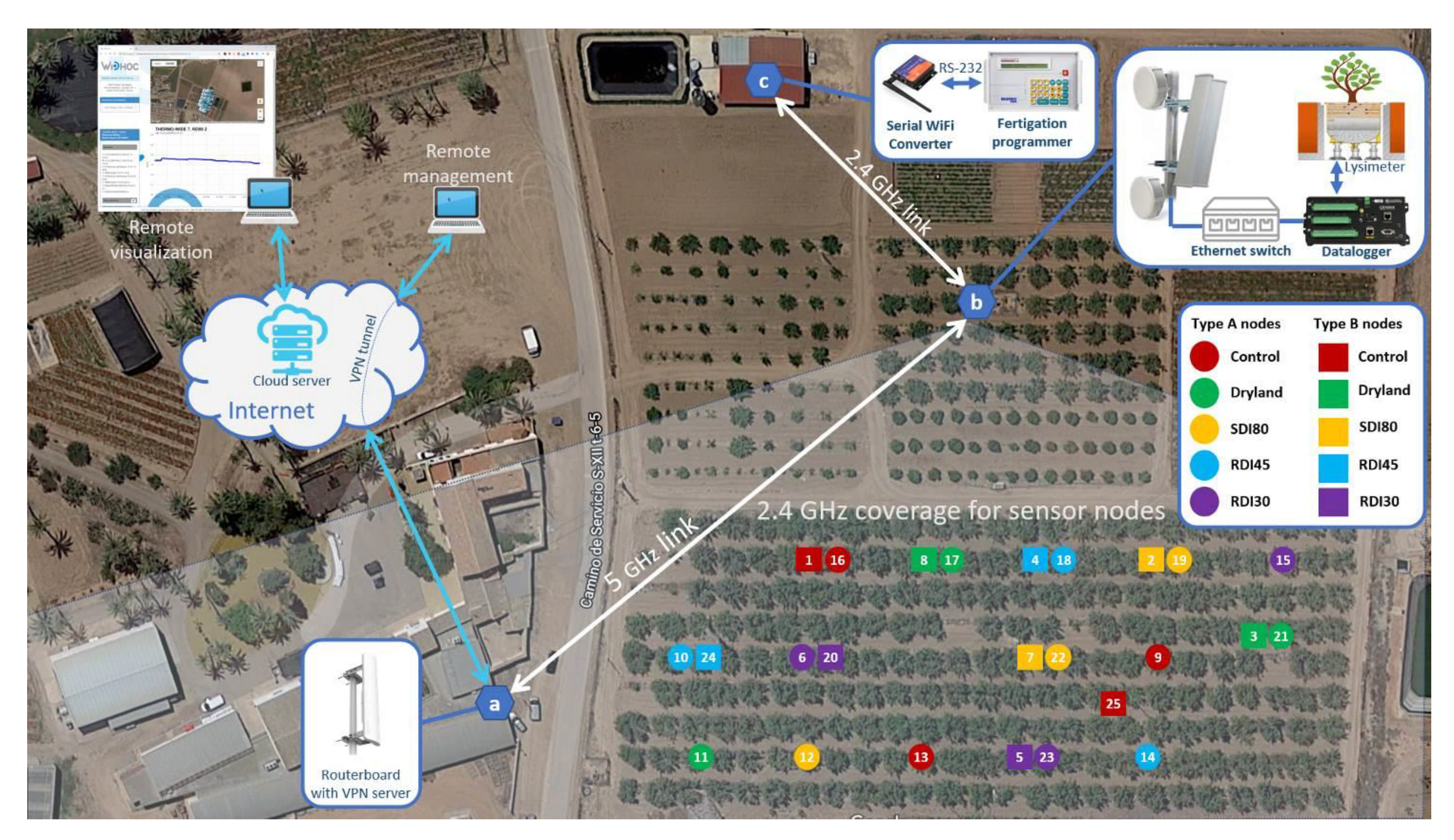

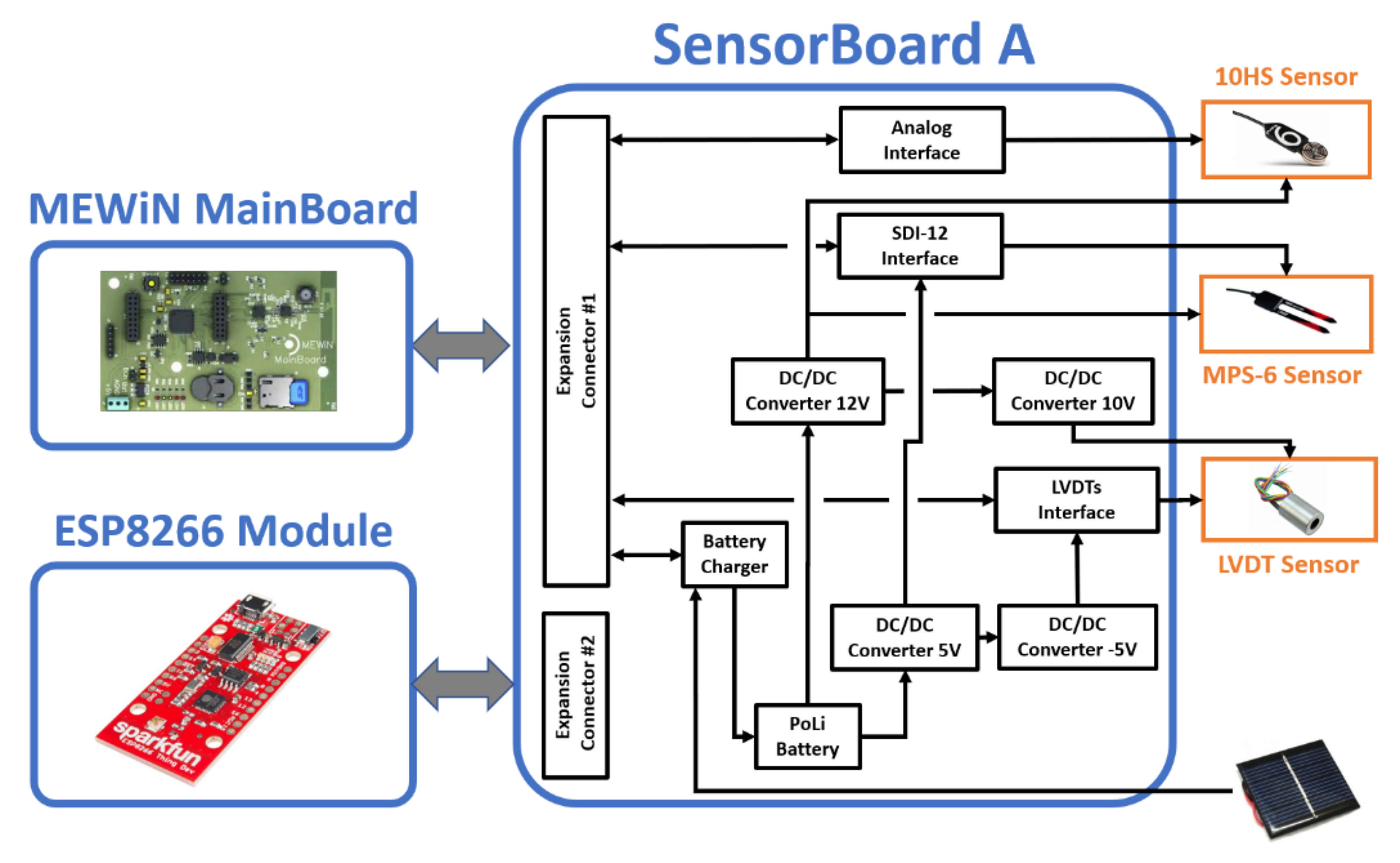
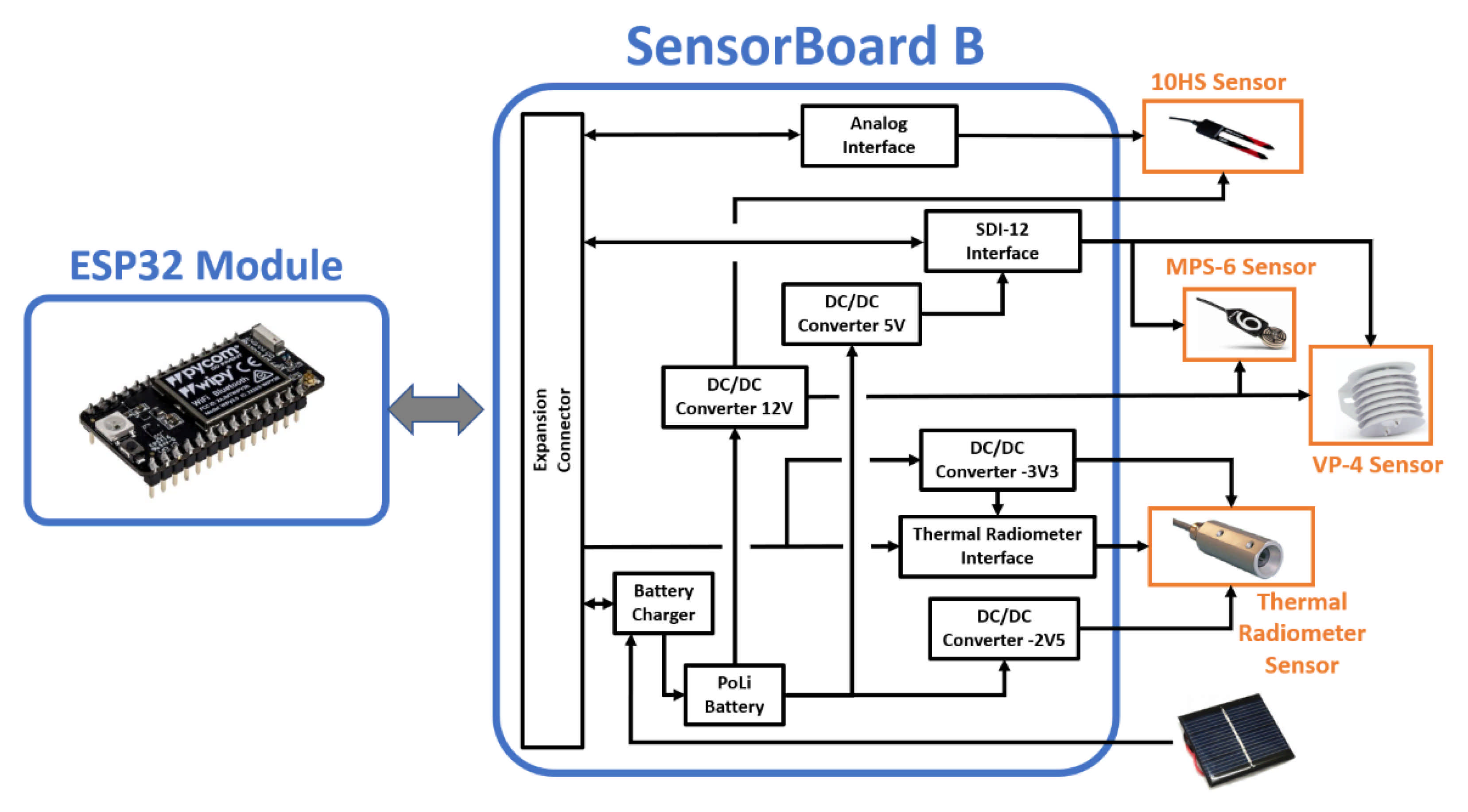
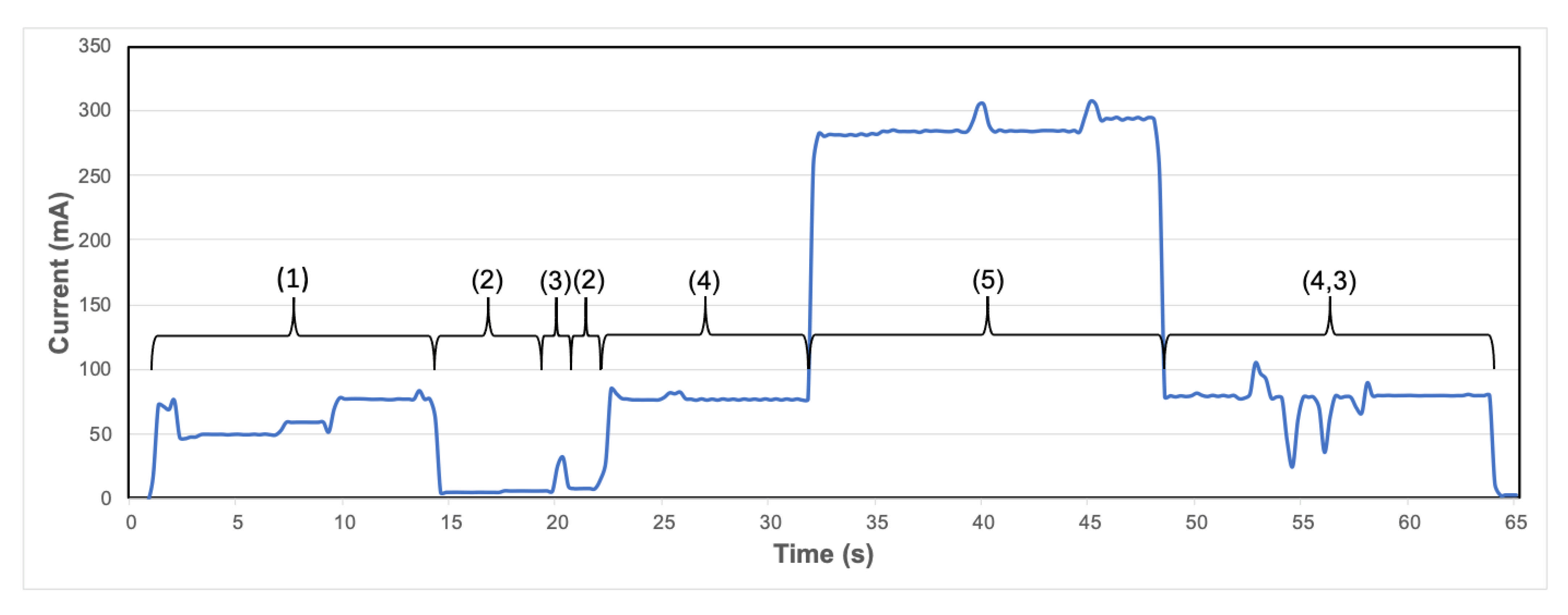

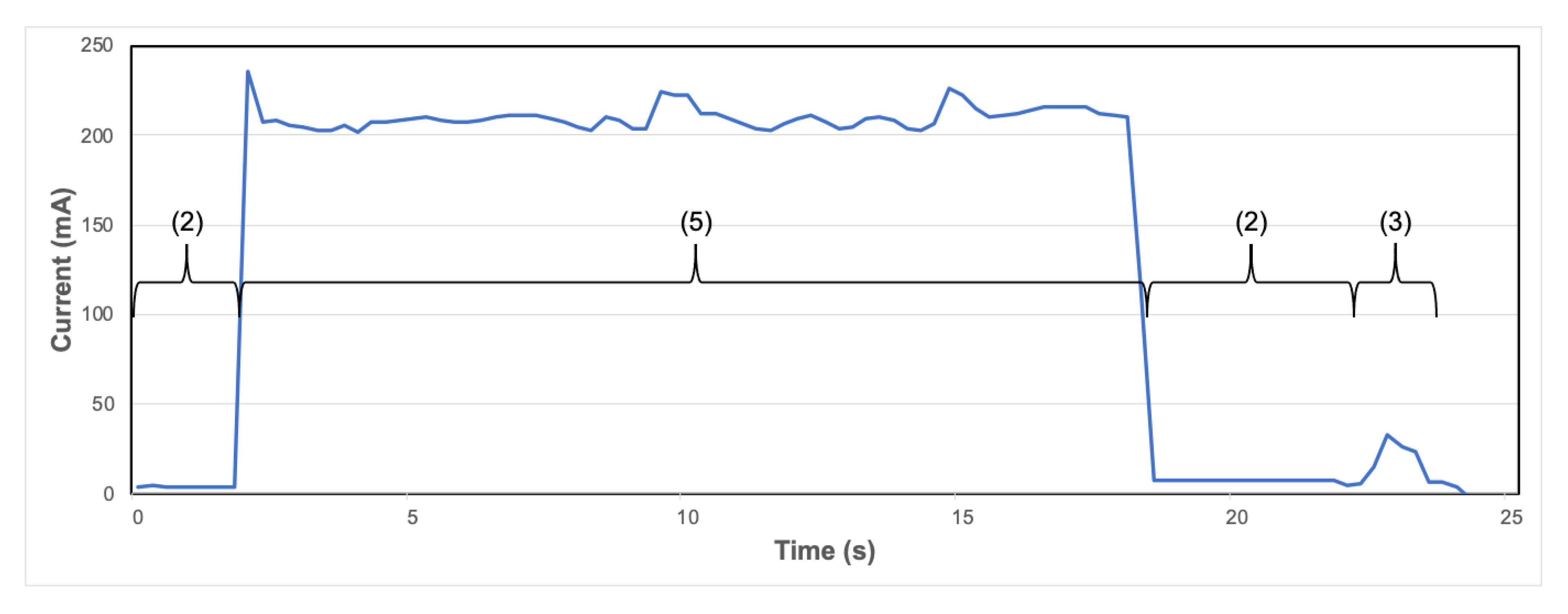


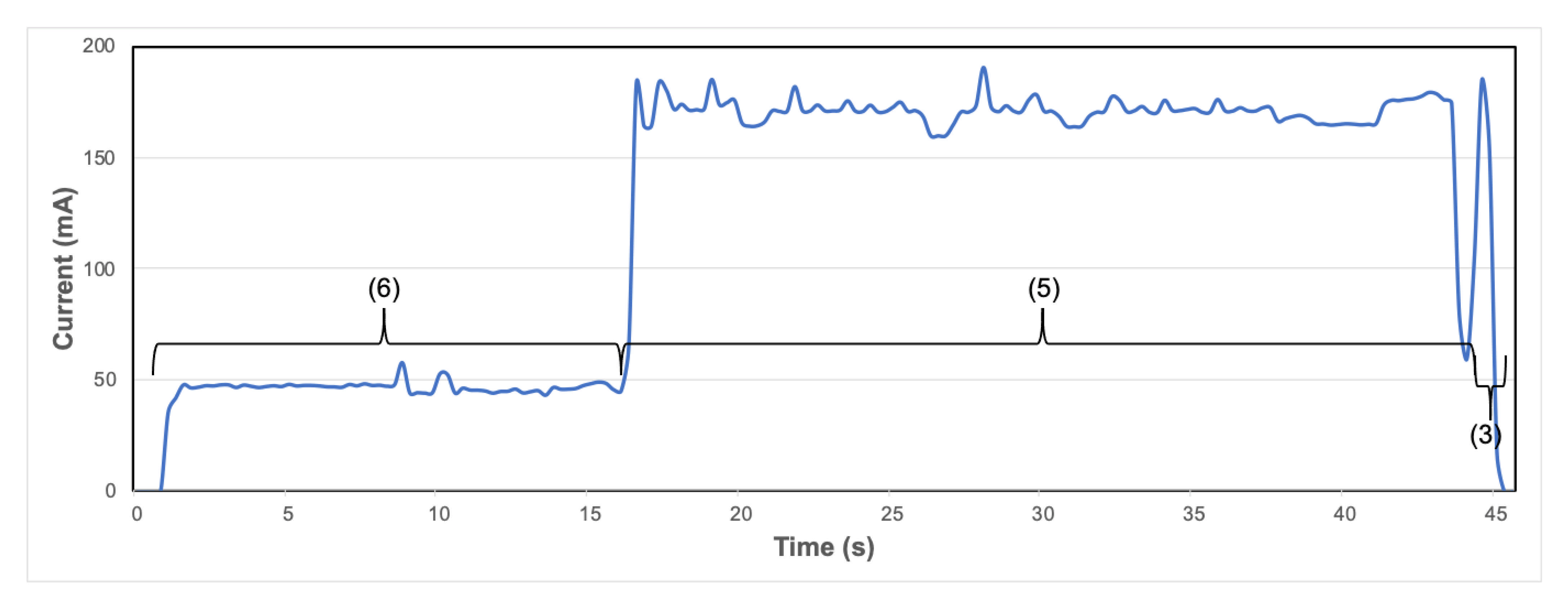
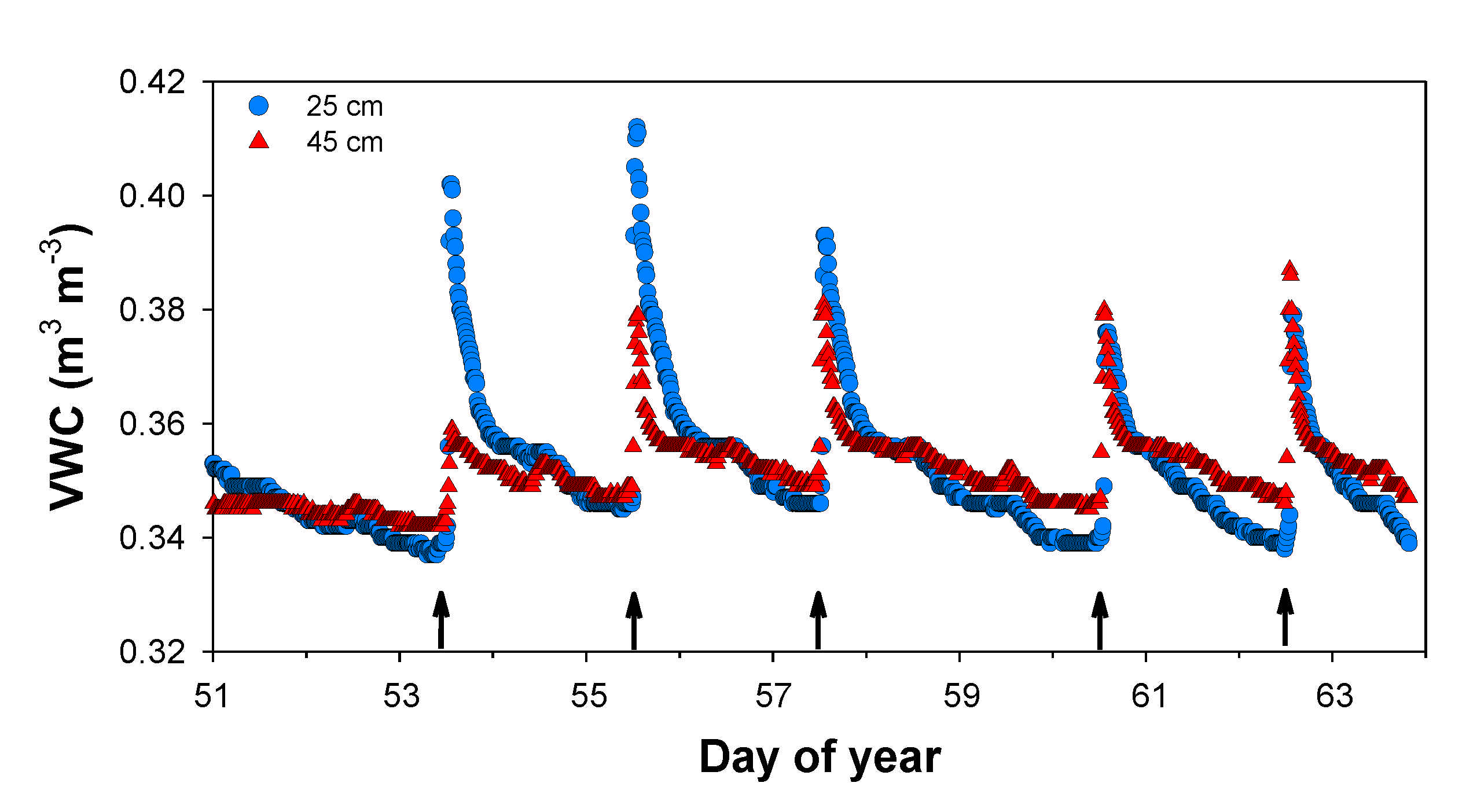
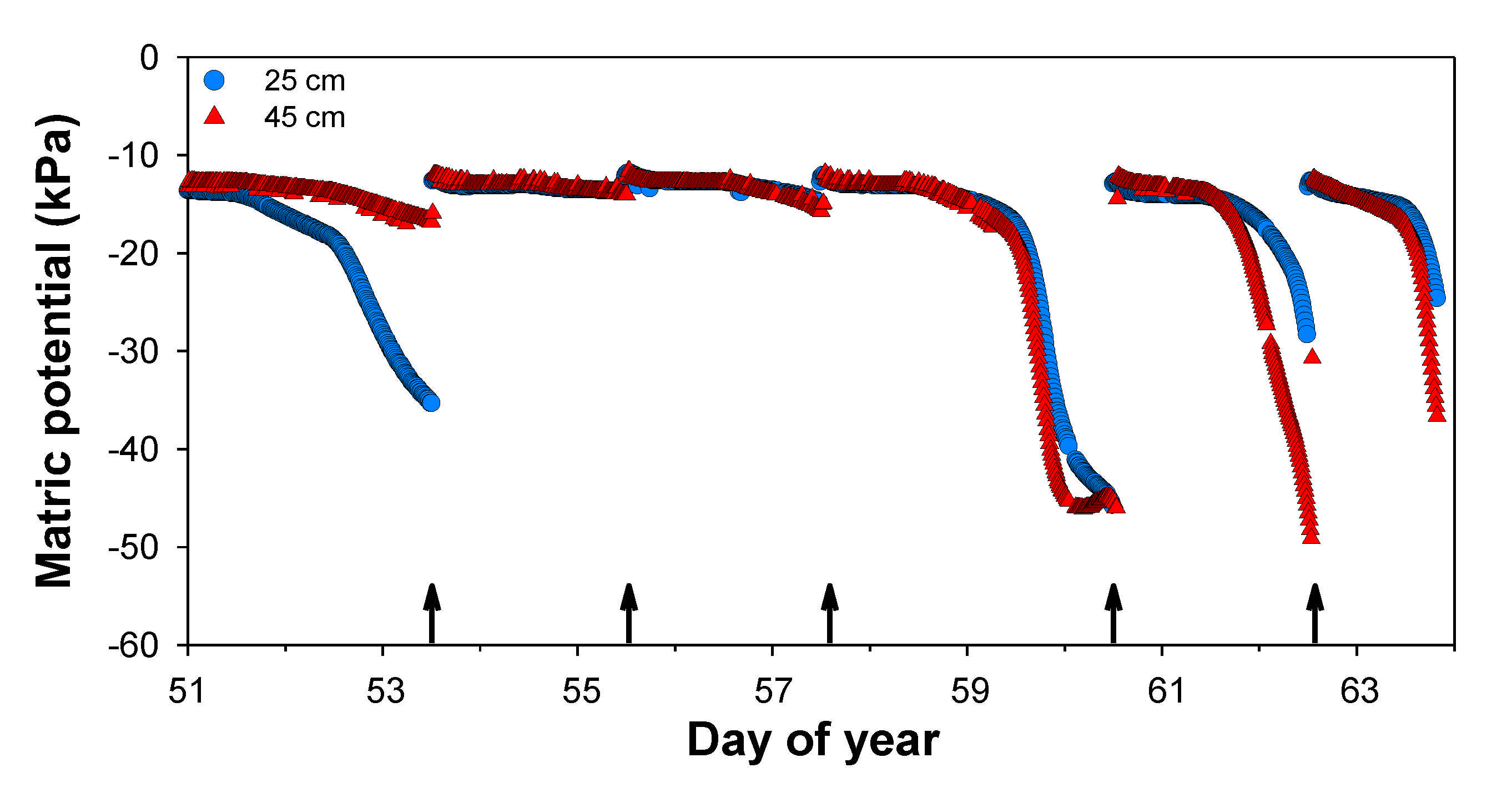
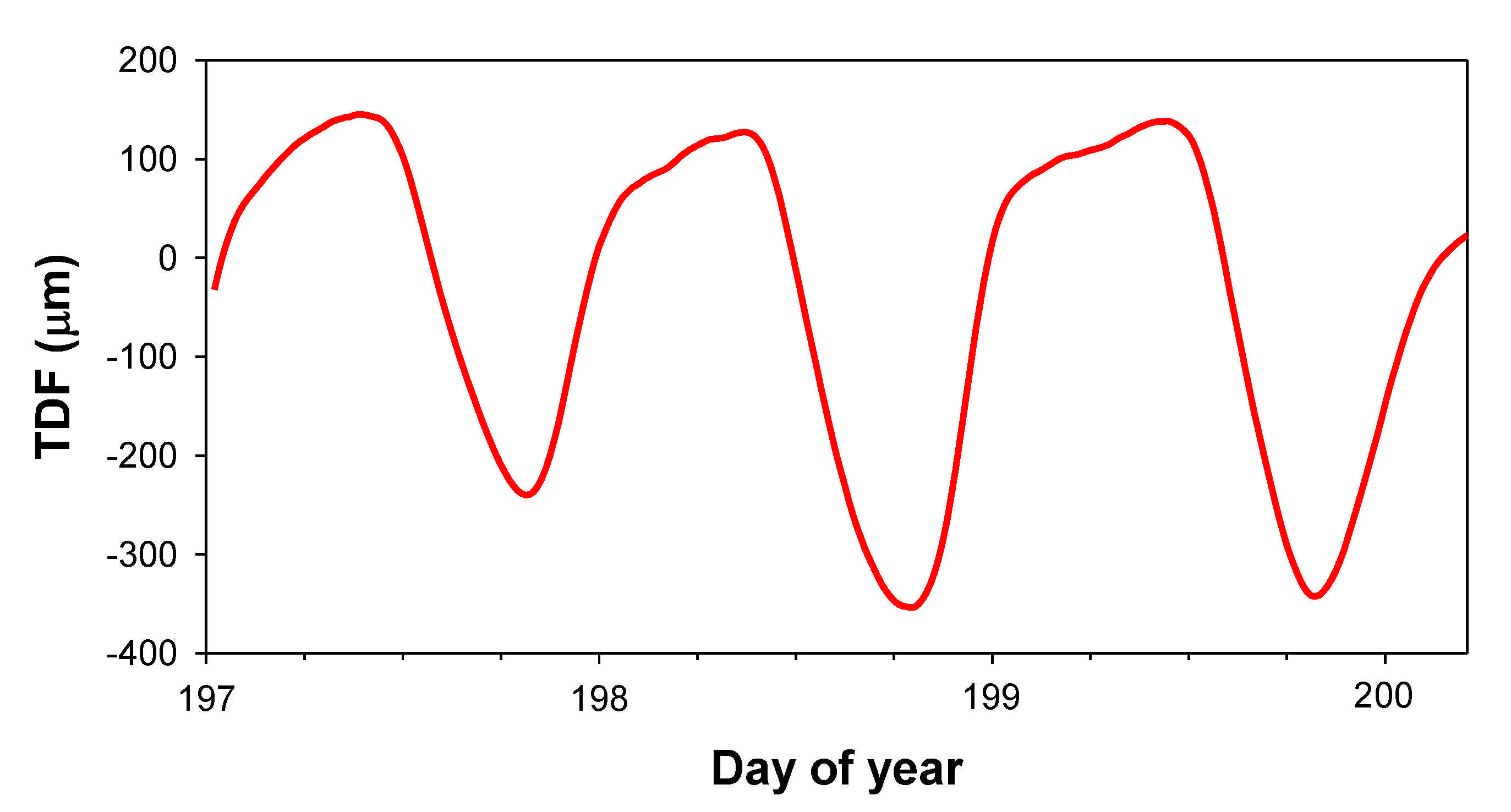
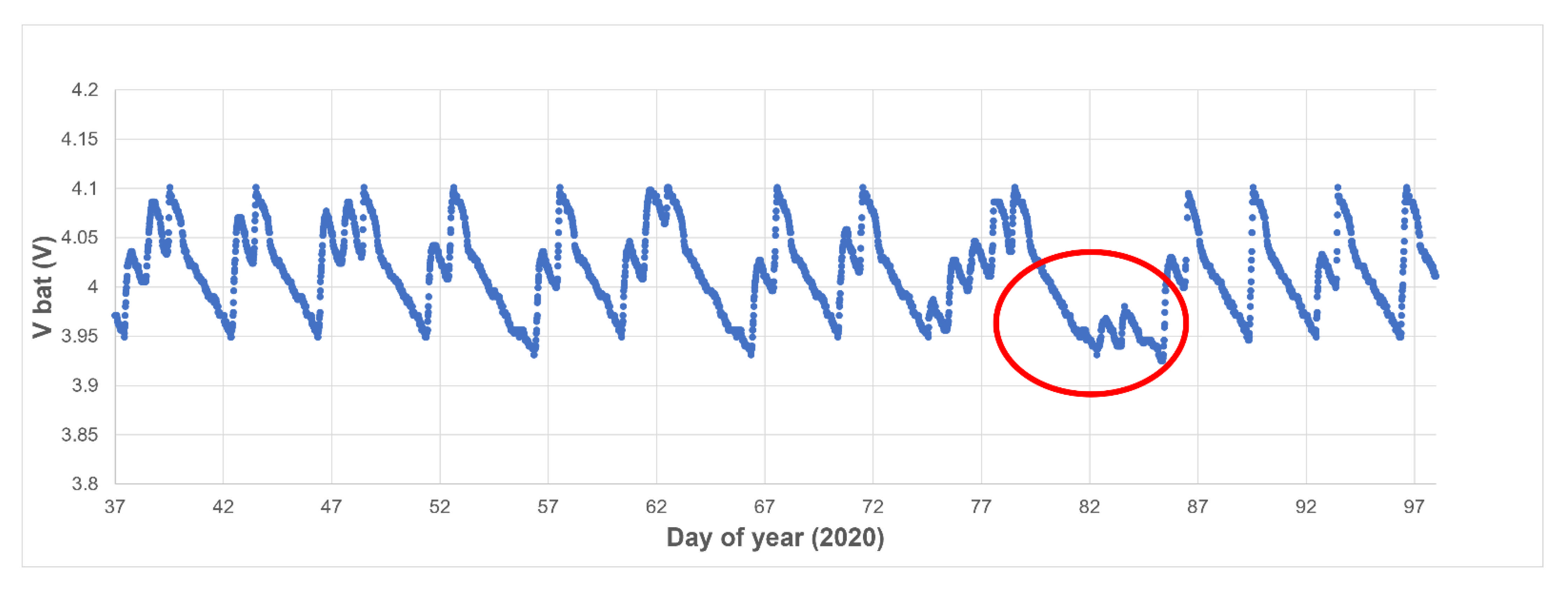
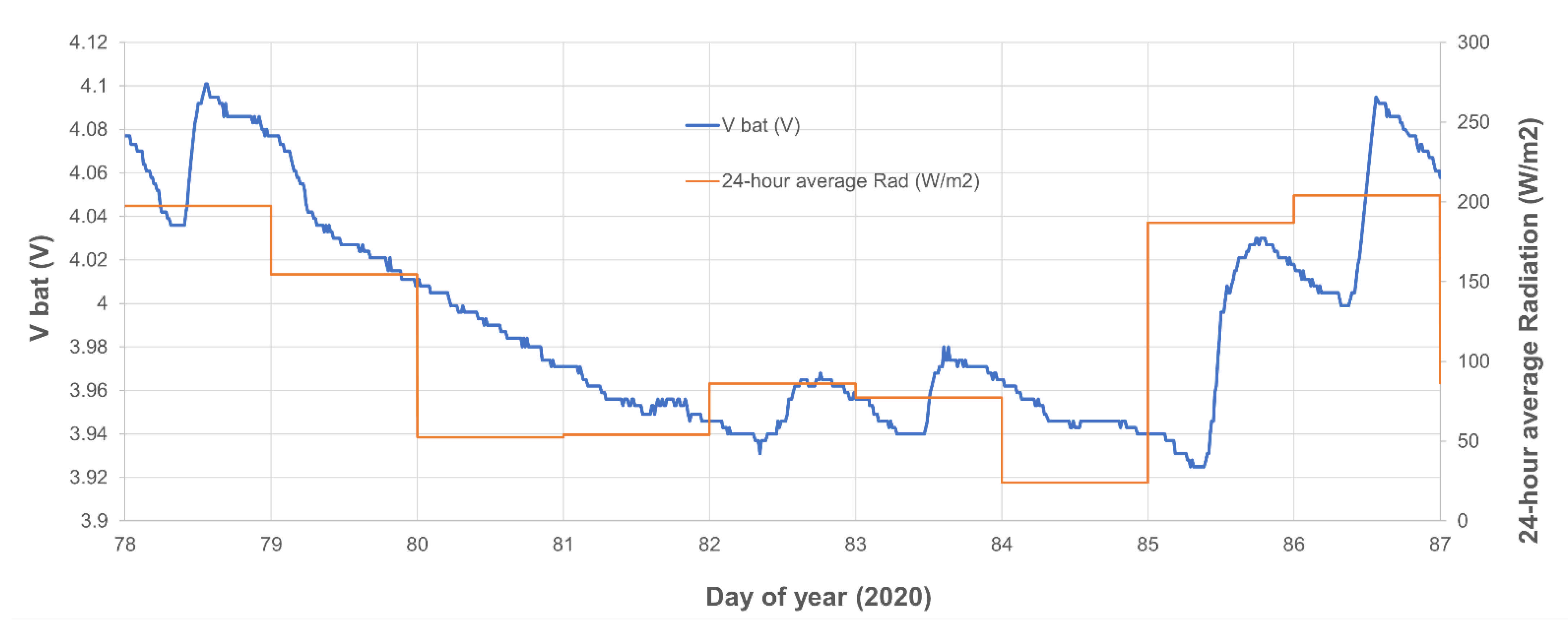
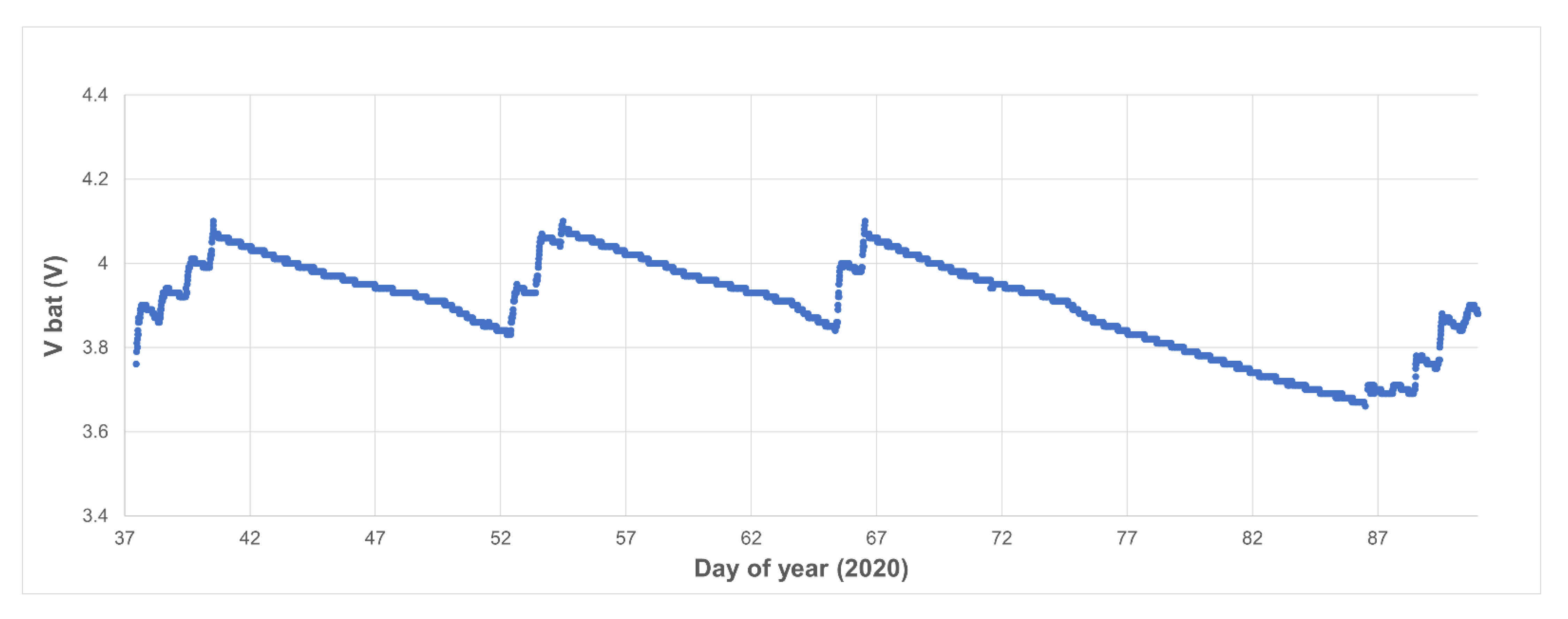
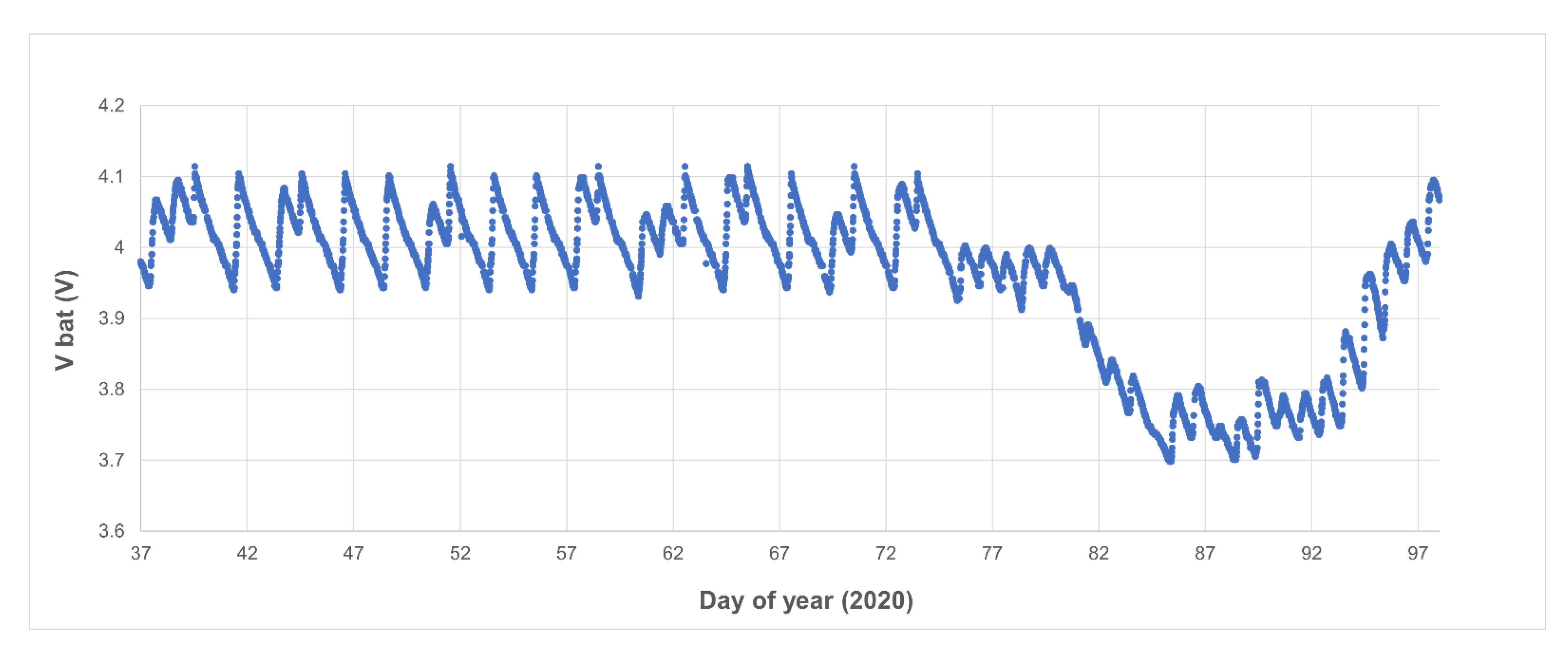
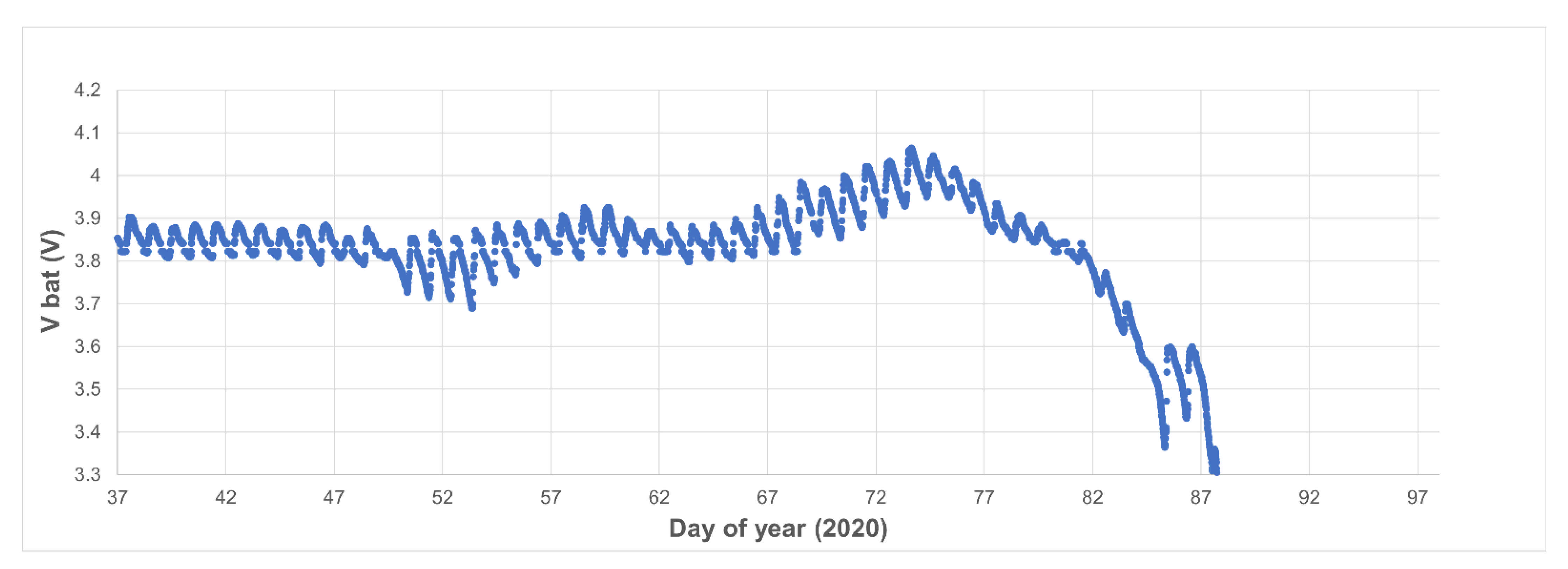
| Sensor | Measured Data | Output | Range | Resolution | Accuracy | Supply Voltage Range | Current Consumption |
|---|---|---|---|---|---|---|---|
| 10HS 1 | Soil moisture | 0.3–1.25 V | 0–57% VWC | Not applicable | ±3% VWC | 3–15 VDC | 15 mA |
| MPS-6 1 | Soil matric potential and temperature | SDI-12 | −9 to −100000 kPa | 0.1 kPa | ±10% (from −9 to −100 kPa) | 6–15 VDC | 10 mA |
| −40 to +60 °C | 0.1 °C | ±1 °C | |||||
| LVDT DF2.5 2 | Displacement sensor | 750 mV/mm | ±2.5 mm | Not applicable (analog sensor) | 10–24 VDC | 10 mA | |
| VP-4 1 | Relative humidity, temperature, vapor pressure and barometric pressure | SDI-12 | 0 to 100% RH | 0.1% RH | from ±2 to ±8% | 3.6–15 VDC | 5 mA |
| −40 to 80 °C | 0.1 °C | from ±0.3 to ±0.4 °C | |||||
| 0 to 47 kPa | 0.001 kPa | from ±0.03 to ±0.33% | |||||
| 50 to 110 kPa | 0.01 kPa | ±0.4 kPa | |||||
| IR120 3 | Leaf temperature | 20 mV per °C (difference from sensor body) | −25 to +60 °C | Not applicable (analog sensor) | ±0.2 °C | +2 to +3.5 V (Thermopile) −2.5 V or +400 mV (Thermistor) | 0.4 mA |
| Node Number | Node Type | Replicate | Irrigation Treatment | Sensors |
|---|---|---|---|---|
| 1 | B1 | 1 | Control | 2 10HS, 2 MPS-6, 1 VP-4 and 1 IR120 |
| 2 | B1 | 1 | SDI80 | 2 10HS, 2 MPS-6, 1 VP-4 and 1 IR120 |
| 3 | B2 | 2 | SDI50 | 2 10HS, 2 MPS-6 and 1 IR120 |
| 4 | B2 | 1 | RDI45 | 2 10HS, 2 MPS-6 and 1 IR120 |
| 5 | B1 | 3 | RDI30 | 2 10HS, 2 MPS-6, 1 VP-4 and 1 IR120 |
| 6 | B2 | 2 | RDI30 | 2 10HS, 2 MPS-6 and 1 IR120 |
| 7 | B2 | 2 | SDI80 | 2 10HS, 2 MPS-6 and 1 IR120 |
| 8 | B2 | 1 | SDI50 | 2 10HS, 2 MPS-6 and 1 IR120 |
| 9 | A1 | 2 | Control | 2 10HS, 2 MPS-6 and 2 LVDT |
| 10 | A1 | 2 | RDI45 | 2 10HS, 2 MPS-6 and 2 LVDT |
| 11 | A1 | 3 | SDI50 | 2 10HS, 2 MPS-6 and 2 LVDT |
| 12 | A1 | 3 | SDI80 | 2 10HS, 2 MPS-6 and 2 LVDT |
| 13 | A1 | 3 | Control | 2 10HS, 2 MPS-6 and 2 LVDT |
| 14 | A1 | 3 | RDI45 | 2 10HS, 2 MPS-6 and 2 LVDT |
| 15 | A1 | 1 | RDI30 | 2 10HS, 2 MPS-6 and 2 LVDT |
| 16 | A2 | 1 | Control | 2 LVDT |
| 17 | A2 | 1 | SDI50 | 2 LVDT |
| 18 | A2 | 1 | RDI45 | 2 LVDT |
| 19 | A2 | 1 | SDI80 | 2 LVDT |
| 20 | A2 | 2 | RDI30 | 2 LVDT |
| 21 | A2 | 2 | SDI50 | 2 LVDT |
| 22 | A2 | 2 | SDI80 | 2 LVDT |
| 23 | A2 | 3 | RDI30 | 2 LVDT |
| 24 | B3 | 2 | RDI45 | 1 IR120 |
| 25 | B3 | 2 | Control | 1 IR120 |
| State | 1 | 2 | 3 | 2 | 4 | 5 | 4, 3 |
| Description | Time synchronization | Task signaling | Access to microSD | Task signaling | Data sending | Sensors reading | Access to microSD and data sending |
| Iaverage (mA) | 61 | 4.6 | 21 | 7.1 | 74 | 282 | 75 |
| Duration (s) | 13 | 6 | 0.5 | 1 | 10 | 16.5 | 15 |
| State | 2 | 5 | 2 | 3 | 2 | 4 |
| Description | Task signaling | Sensors reading | Task signaling | Access to microSD | Task signaling | Data sending |
| Iaverage (mA) | 4 | 206 | 7 | 23 | 4.5 | 76 |
| Duration (s) | 2 | 16.5 | 3.5 | 1 | 4 | 15 |
| State | 2 | 5 | 2 | 3 |
| Description | Task signaling | Sensors reading | Task signaling | Access to microSD |
| Iaverage (mA) | 4 | 208 | 7 | 16 |
| Duration (s) | 2 | 16 | 3.5 | 1.5 |
| State | 1 | 6 | 5 | 3, 4 |
| Description | Time synchronization | Sensors preheating | Access to microSD | Access to microSD and data sending |
| Iaverage (mA) | 61 | 4.6 | 21 | 74 |
| Duration (s) | 13 | 6 | 0.5 | 10 |
| State | 6 | 5 | 3 | 4 |
| Description | Sensors preheating | Sensors reading | Access to microSD | Data sending |
| Iaverage (mA) | 46 | 170 | 150 | 100 |
| Duration (s) | 14 | 17 | 1 | 10 |
| State | 6 | 5 | 3 |
| Description | Sensors preheating | Sensors reading | Access to microSD |
| Iaverage (mA) | 46 | 170 | 150 |
| Duration (s) | 14 | 17 | 1 |
Publisher’s Note: MDPI stays neutral with regard to jurisdictional claims in published maps and institutional affiliations. |
© 2021 by the authors. Licensee MDPI, Basel, Switzerland. This article is an open access article distributed under the terms and conditions of the Creative Commons Attribution (CC BY) license (http://creativecommons.org/licenses/by/4.0/).
Share and Cite
Jiménez-Buendía, M.; Soto-Valles, F.; Blaya-Ros, P.J.; Toledo-Moreo, A.; Domingo-Miguel, R.; Torres-Sánchez, R. High-Density Wi-Fi Based Sensor Network for Efficient Irrigation Management in Precision Agriculture. Appl. Sci. 2021, 11, 1628. https://doi.org/10.3390/app11041628
Jiménez-Buendía M, Soto-Valles F, Blaya-Ros PJ, Toledo-Moreo A, Domingo-Miguel R, Torres-Sánchez R. High-Density Wi-Fi Based Sensor Network for Efficient Irrigation Management in Precision Agriculture. Applied Sciences. 2021; 11(4):1628. https://doi.org/10.3390/app11041628
Chicago/Turabian StyleJiménez-Buendía, Manuel, Fulgencio Soto-Valles, Pedro José Blaya-Ros, Ana Toledo-Moreo, Rafael Domingo-Miguel, and Roque Torres-Sánchez. 2021. "High-Density Wi-Fi Based Sensor Network for Efficient Irrigation Management in Precision Agriculture" Applied Sciences 11, no. 4: 1628. https://doi.org/10.3390/app11041628
APA StyleJiménez-Buendía, M., Soto-Valles, F., Blaya-Ros, P. J., Toledo-Moreo, A., Domingo-Miguel, R., & Torres-Sánchez, R. (2021). High-Density Wi-Fi Based Sensor Network for Efficient Irrigation Management in Precision Agriculture. Applied Sciences, 11(4), 1628. https://doi.org/10.3390/app11041628






